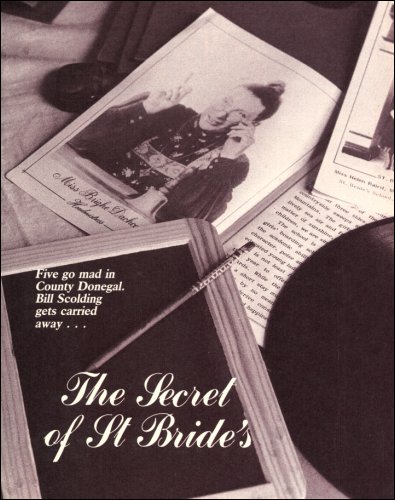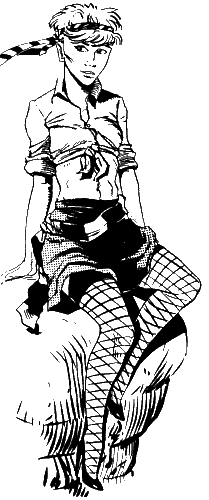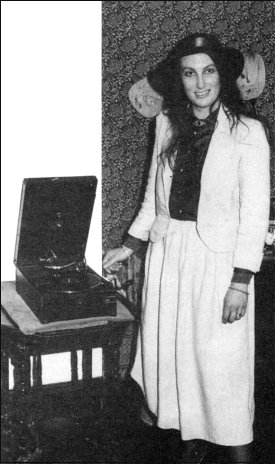| Back to School |

BING CROSBY hisses. Rain water drips from a damp patch above the bay window.
Painted eggs, miniature elephants and celtic jewellery crowd the table tops and the heavy Victorian mantlepiece. Framed pictures of girls brandishing hockey sticks are propped behind a stack of classroom slates. The phonograph winds down, Bing crackles to a finish, and the hiss fills the room.
The five of us - a motley deputation from the computer press - are in the tea room at St Bride's, a white crumbling turn-of-the-century house overlooking the tiny fishing village of Burtonport, in County Donegal. Mists roll in across the rocky coastline and the moors stretch behind, dotted with scraggy sheep and thatched cottages deep in peat.
The tea room is dark and a bit damp. There is something else about it, not perceived at first. There is no electric light, no light switch, no sockets.
The 1980s slip away ...
St Bride's is a school for young ladies between the ages of 13 and 18. Here are some lines from its prospectus: "The girls receive the healthy benefit of lively sea air and fresh open countryside, and in the matter of sunshine, so vital to the health of growing children, we are singularly well favoured.
"St Bride's offers a standard classical curriculum, the cardinal subjects being Mathematics, Elementary Latin, Grammar and Literature ... The day begins with the rising bell at half-past seven ... The School has a modern gramophone which may sometimes be used by an unsupervised group of girls, providing that great care is taken to avoid overwinding."
St Bride's is a surreal holiday where grown-up women relive their childhood fantasies by dressing up in pinafores and bonnets and going back in time to a 20s boarding school.
St Bride's is a young software house whose first game was, appropriately, The Secret of St Bride's.
St Bride's is ...
Marianne Scarlet and Priscilla Langbridge, the Games Mistresses of St Bride's, are very much larger than life, a phrase they often use to describe themselves. Flamboyant in wide-brimmed bonnets and matching two-pieces, they are impressively dramatic. Those are their real names, though not the names they were born with, for, as Priscilla explains, "one's real name is the name you are using at the time".
Marianne is also headmistress of the school. On the back of the prospectus she is billed as Miss Brighe Dachcolwyn, another real name. As she pours the coffee - or possibly tea, none of us are sure, but it is undrinkable - she travels back in time to the hazy beginnings of the school.
"Partly it was 'what we do with this big house?'" - she waves her hands expansively - "and partly my background in humanistic psychology, the right sort of background for an unusual idea. I did know about the unhappiness of the modern person. I felt what was missing was some of the feelings from old-fashioned books - that you could trust people, that they would support you - good, old-fashioned upright ideas ...
"We wanted to give people the experience of being teenagers again. One of the ways to create that effect was a school environment in an unfamiliar time - an imaginary '20s or '30s."
The school was advertised widely, in the Observer, the Sunday Times, Girl About Town, and in the theatre programme for Daisy Pulls it Off. News also got around by word of mouth.
The girls who attend are aged between 20 and 30 - "Nurses, teachers, office workers, people who are interested in seeing the psychological effect take place on themselves." The absence of electric power, and the garishly painted dormitories, reinforce the effect.
About 80 attended this season, a maximum of eight a week, and while most are from England, some have come from America and Sweden. Those who would have difficulty fitting in tend to weed themselves out before they arrive. They take lessons, go out on nature rambles, buy tea in the tea room with old money. The role-playing continues 24 hours a day: "There is a strong atmosphere even when the staff are not present. People come for the experience but accidentally sharpen their wits. They also discover about friendship - it's very heartwarming."

Do they enjoy any schoolgirl adventures? Marianne's eyes twinkle under the swathes of violent eyeshadow, "Three or four girls might go out and rather excitingly get cut off by the tide."
Well, it's not so different from grown-up boys hitting each other with cardboard axes at Treasure Trap Castle, but how do the Burtonport villagers take to life at St Bride's?
"We get on very well with the locals. We print the labels for the fishermen's co-operative and do the posters for the horse races. Irish people don't think the same as the English, they love people making a splash. They have a phrase, 'to have a bit of crack' which means you're up there at the top.
"I'm considered the best dressed woman in Burtonport."
The second best dressed woman in Burtonport has been quiet so far demurely fanning herself with a white fan. Previously a freelance writer Priscilla first came to St Bride's as a pupil. She brought with her a second hand Commodore 64, and somewhere found a socket to plug it into. Marianne was a bit taken aback at this intrusion of the modern world into the real world of St Bride's but they played a few arcade games and, as Priscilla adds, "we discovered that she had this penchant for blasting things."
"I didn't have any experience of computers," explains Marianne. "My experience was in thinking backwards. But I found they were wonderful, they were magical." She laughs. "I'm a great fan of racing car games."
Their first game, The Secret of St Bride's, grew out of the mystery games which the girls played on their afternoon rambles. The aim was to notice odd things which they passed, pretend that those were clues and work out the mysterious connections between them.
The game was started on the C64 using Quill, and finished on the Spectrum when Priscilla discovered the delights of the 48K wonder.
The cover of the early version depicted Marianne in fine cane-wielding form, but on the inside appeared a barely-clad Amazon. The copy, too, was ever so slightly teasing: "You are Trixie Trinian ... You've come to St Bride's for a school holiday, but things aren't quite the way you expected - in fact they're very strange indeed! Explore the classrooms and the dormitories to find the school's dark secret.
Our very own Richard Price awarded the adventure five stars, and sales to date total a couple of hundred mail order. But now a deal has been struck with Audiogenic, which is taking over the packaging, duplication, distribution and advertising, though the Games Mistresses are continuing with their suggestive press releases, featuring their peculiar and appealing sense of humour. Apparently, Priscilla is always drunk when she writes them, which explains a lot.
Plans are afoot, and well advanced too, for many more games. One for release soon is Unexpurgated Caves. As Priscilla explains, it is a tribute to the original Crowther-Woods mainframe adventure, Colossal Caves. The press teaser reads: "... even before Crowther-Woods there was a very early protocaves original. Nobody could produce a version of it, or even mention it except under severe penalties. We can now reveal the reason for this extraordinary embargo: the original game was considered TOO SILLY to bring before the public. It made Monty Python look like War and Peace."
Priscilla waxes lyrical. "I like the economy of it. I like the two-word input, the over-use of 'get' and 'drop'. It's useful to have a very simple command structure which can be used inventively. People make a fetish of over-sophistication."
Nearly out is The Snow Queen, the first of St Bride's Living Books, previewed in November's Sinclair User. The idea is for the program to be packaged with a facsimile edition of the original book. Others in the series include Raffles and Alice.

Marianne winds up Bing Crosby |
Much more ambitious are the software/comic tie-ins, Wondergirl and Silverwolf, each scheduled for the new year and each packaged with a comic. Priscilla has an enviable knowledge of the more obscure comic strips, and has indulged in some cheerful piss-taking. Wondergirl begins with the prediction by Professor Jorrell of the planet's imminent destruction. His daughter is despatched by rocket, and on its path it passes through the obligatory asteroid belt, imbuing the child with superpowers. Unfortunately, Jorrell is wrong, the planet is saved, and Wondergirl returns to champion truth, justice and the Irish way from her base in the home counties.
Silverwolf appears to be more serious. Priscilla passes round some roughs for the strip artwork, and we scrutinise some frames which wouldn't appear in Bunty.
Both programs might need an entirely new system for writing adventures. "We're working on it," as Priscilla says. 'We' is a programming team of two, Priscilla and the elusive Maureen, but possible expansion might encompass "a machine code programming chap in Sligo".
Both the Games Mistresses deny that their software is particularly aimed at the female market, although Marianne says that they would like it to appeal to women. "Perhaps girls are embarrassed about playing zapping games ..."
We leave the tea room for a conducted tour of the school, Marianne's gestures growing ever more sweeping as she shows us the ancient desks with their inkwells, the dormitories of matching candlewick bedspreads, the panelled walls, the stained paintwork ... "The plaster was mixed with sea salt, which grows crystals which expand and contract with the tides and the strength of the moon." We are treated to a privileged sight of the new telephone, replacing the old wind-up version which made communicating with St Bride's such an amusing pastime.
Marianne entertains us with stories of the house's history, of IRA gunmen in the '20s hiding out in false crockery cupboards, dressing up as women to escape the soldiers. Back in the tea room, she is effusive. "I don't like the modern world, and I don't live in it. I'm not a modern person ... I don't act, I just do it."
As we drive off, we look back at them, two figures in a landscape, part of it and apart from it, holding their bonnets against the buffeting wind.
Days later, when I'm writing this article, I find the real world of St Bride's - its dark rooms, its waxing and waning walls - beginning to fade. Neon lights the office, telephones ring, typewriters buzz, graphics flicker on TV screens. Everywhere is Electricity.
I decide to try out St Bride's new STD number. In a matter of hours I'm speaking once more to the Games Mistresses, who've just returned from the pub - I have this mental picture of Marianne and Priscilla, hats and all, carousing with Irish fishermen, their fists full of Guinness.
I try to convey how incredible the visit now appears, how it has taken on the feel of a theatrical performance.
Marianne: "There's much less of what people think of as real life and much more fantasy in every waking moment in this house."
What is the secret of St Bride's?
Priscilla (long silence): "I suppose ... to rub out the lines between fantasy and real life."
Yes.